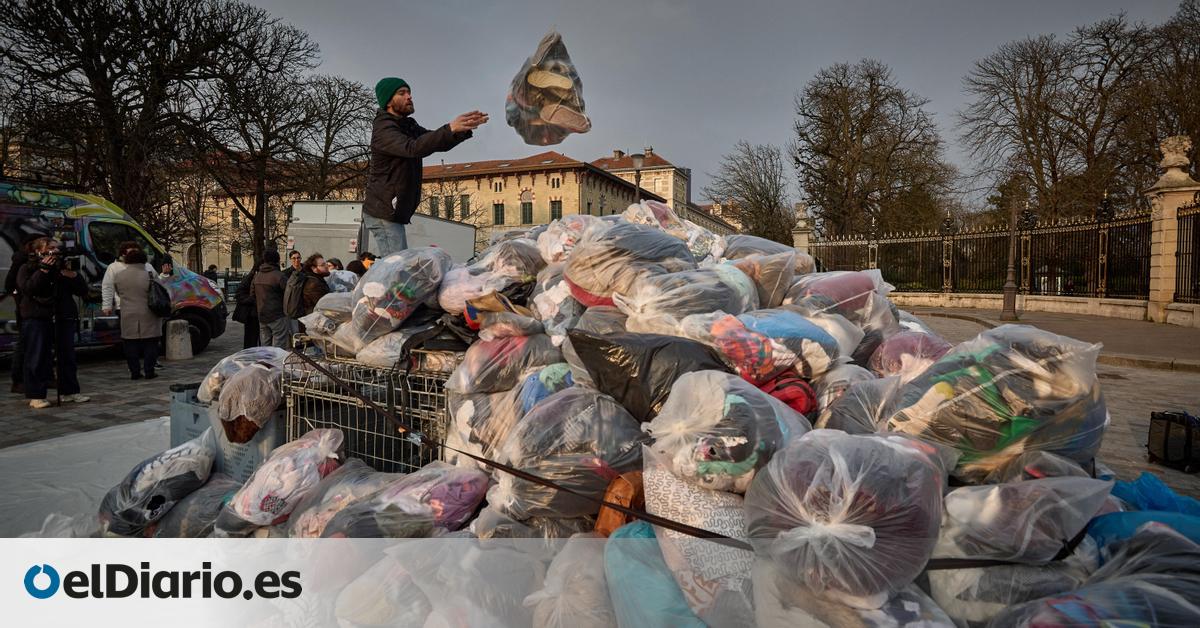
Clothing and footwear manufacturers will have to take over and pay a system of textile garbage that generates their business. This is reflected in the Royal Decree project prepared by the Ministry of Ecological Transition, which has just been put to public information.
The concrete article says that they will be obliged to “finance and organize, totally or partially, the collection and treatment of the waste of textile and footwear products.”
The garbage that comes from fashion – especially fashion to use and throw or fast fashion– It is generating a giant waste mountain every year. From approximately one million tons of these waste, 80% ends in the landfill or burned. The system of fast fashionthat renews seasons in an accelerated way, makes, although the double clothes that 20 years ago are used, half of time, half of time. The formula is: a lot of very disposable ephemeral articles that then end up in garbage dumps without further ado.
The idea of the norm, still in project, is to reduce the amount of garbage based on discarded clothing and footwear. As for figures, the draft indicates that, by 2030, that weight registered in 2027. And raise that percentage to 10% in 2035 must be cut by 5%.
And, in terms of recycling, ecological transition draws collection objectives: half of the waste generated must recover selectively in 2025 and reach 70% in 2030, “throughout the Spanish territory.”
The Ministry admits in the justification memory of the decree that “textile and footwear have become one of the priority waste flows in the European sphere due to the great increase in global production and consumption” and emphasizes that “this flow of waste is considered the fourth largest of the European Union with respect to its environmental impact and on climate change and the third in use of water and territory.”
“Society is already aware”
“It is fine that these regulations come out, because society is already aware of the contamination of textiles, but they are policies that continue to be based on waste collection,” analyzes the head of Sustainable Consumption of Greenpeace, Celia Ojeda. “The ministry recognizes that the issue of textiles and shoes and their waste is a problem and, nevertheless, the objectives seem scarce. It should be more ambitious.”
Along these lines, the normative project requires that, within five years, “at least 20% of the weight of waste” are prepared to reuse. And in a decade (in 2035) reach 35%. “The recovery of the waste of textile and footwear products of the rest of the rest will be maximized thus contributing to the fulfillment of the management objectives established for municipal waste,” includes the articulate.
Spain continues to comply with the levels of recycling of municipal waste established in European regulations and the “rest” fraction (where it is mixed without selecting trash that then cannot be reused or recycled) is behind this breach.
“We miss that there is clear and strong regulations that encourage reuse and repair,” insists Ojeda. “If you are admitting that the textile sector is generating a problem of great magnitude you should make a decree in which more weight is put in repair and second hand. And that does not exist.” In other words: “That it is not cheaper to buy new shoes than to fix them,” summarizes the environmentalist.
The margin of improvement in that specific aspect is enormous. A couple of months ago, a counting of the Human Foundation showed how far Spain is that the second -hand shops circuit is a relevant tool to face the problem of constant and growing flow of textile waste: they counted 800 clothing stores used in front of, for example, 10,000 registered in Great Britain.
Material collection points
Back to the system that will have to be launched, the Ministry establishes that the collection of waste is done at points that manufacturers or distributed by the municipalities, in addition to points of social economy entities. Likewise, those who sell clothes or footwear – compensation and distributors – must “collaborate in the separate collection” if “so expected” the management system organized by manufacturers.
To finish off, the “holders” of these products “in no case can waste leave in the environment or outside the collection points.” Forbidden to throw clothes or shoes used anywhere.
This Royal Decree is a first movement to partially limit the environmental damage generated by the ultra -granted fashion model. In this case, the accent is especially in the collection of waste and its possible reuse or recycling. For Celia Ojeda, “just managing the garbage does not work. Collect sounds very good, but we return to place the pressure in consumers without addressing that we continue to produce textiles and shoes above our possibilities to manage them. If we do not have alternative ways to give way to the waste we will find the same situation as with the plastic: export to countries in worse conditions to leave the textile in their landfills.”
However, just over a year ago, France approved a law that focused the problem from another perspective: prohibit advertising and loading garments with a green rate to cut the flow of clothing from the origin and thus reduce the volume of garments that is put into circulation.
Source: www.eldiario.es

